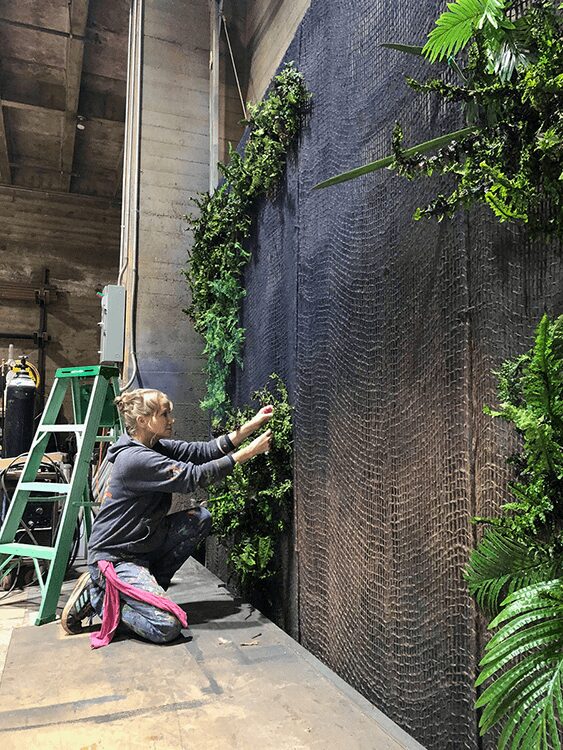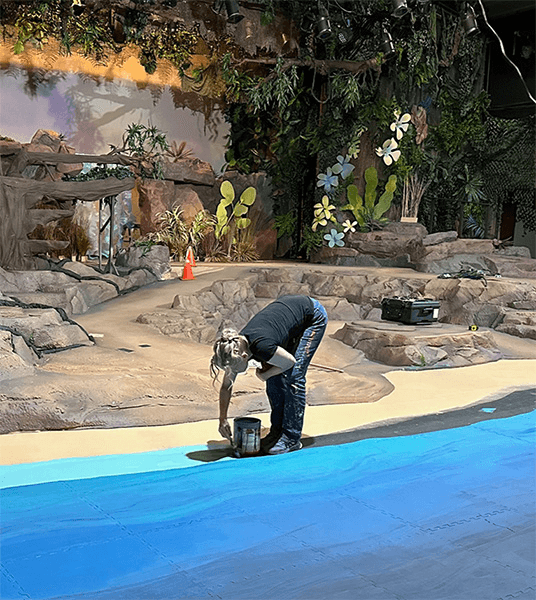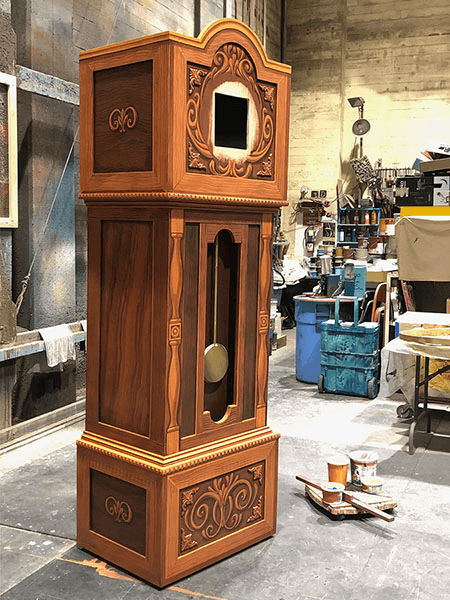Alright – so today we’ve got the honor of introducing you to Johnny Painter. We think you’ll enjoy our conversation, we’ve shared it below.
Johnny, looking forward to hearing all of your stories today. Can you talk to us about how you learned to do what you do?
I stumbled upon Scenic Arts by accident. As a child, I had never been to a live stage show, but when my big sister entered college for a Theatre Arts major, she told me, “You have to see this. The sets are amazing.” Cal State Long Beach had a fabulous Theatre Arts faculty at that time. Set Designer and Scenic Arts professor Herb Camburn taught me all the crafts that make live theatre so interesting; set design concept and construction, painting of elements and backdrops, foam sculpture, design and building of puppets and props among numerous other skills. He taught East Coast style as well as West Coast, starting with the traditions of live stage set building and taking us through to movie and television production. I took to it all like a natural and soon Herb was urging me to take paid work. “You will learn even more in the field,” he said.
Back then, schools and colleges didn’t do much to guide a student towards success. I believe they actively try to put kids on a path now, but I was really left to float. I got on incredibly well in Set Design and Scenic Arts, but had little interest in my other studies. Soon I found I had completed all the classes available in the Theatre Arts department, but was a few math and science classes short of a degree. Now my professor Herb was famous for supplying Disney with Imagineers. He had brought in a guest speaker from Disney, a former student, and he actually told us, “Your degree won’t matter. What will is your skill set. If you can do the work, that is what will get you the jobs.” Perhaps it was true at the time, but I think we all know, it didn’t stay true! I left college without the degree.
As far as I can tell, not having a degree only lost me a job once. I have always worked. I am a professional Scenic Artist with hundreds of successful shows under my belt. I have painted for a wide array of production companies, in live theatre, movies and television, the most famous and the biggest. Of course I wish I had finished my degree, but it hasn’t stopped me from pursuing my craft professionally.

Johnny, love having you share your insights with us. Before we ask you more questions, maybe you can take a moment to introduce yourself to our readers who might have missed our earlier conversations?
My first love was animation. As a child, I was transported by the beauty of traditional character animation. My family climbed on top of the garage and sitting on the flat roof, overlooking the parking lot of the Drive-In a block away, we watched Disney’s Bambi. Mom says I was two. I sat transfixed. It was the most beautiful thing. I’ve dreamt about that hand-painted fire for the rest of my life. Unfortunately, by the time I was in high school, feature cartoons weren’t being made anymore. Animation was in that lull after the abject failure of The Black Cauldron. I believed the career of character animator was no longer an option. I graduated high school and entered Cal State Long Beach to learn set design. I thought, if I can’t animate for Disney, maybe I can design rides for Disneyland. How was I to know the next golden age of animation was right around the corner? So I found my second true love, Scenic Arts. The creativity was off the charts! They were asking me to conceive of the setting, how it would work, how it would move or change, how it would be built. I loved the grandness of it. The sets were big, I was surrounded by color. I wasn’t just making it up, I was making it happen!
To my surprise, I soon realized that what I enjoyed the most wasn’t the set design, it was the painting. I was happy to let the director and set designer fight it out for a compromise. Once they had agreed on a set design, it was up to me to give it the greatest impact in the time allotted. It is very creative work. A great deal of any set design can be left for me to create. The look of an element, the surface treatments, even the construction can often be left to my judgement. I always get to plus the design. I have great relationships with the designers. They know they can rely on me to lighten their load.
I usually think of myself as a painter, but a Scenic Artist is a complex animal. I understand set design and can often see the difficulties with any set instantly upon viewing the blueprints. I have hands-on experience with a wide array of construction materials. I can mud up an old Venetian wall or sculpt a flagstone floor. I draw well, so I can firm up the more difficult visuals in a design, for example the perspective in a backdrop or the human figures. I love the variety in my work. One day I may be creating a jungle from burlap and silk plants, then next, transferring a drawing to a canvas as big as a two story building. And tomorrow, I will make a puppet from upholstery foam.
Did I forget my first love, animation? Not in the least. After focusing on scenic arts for 10 years, I moved back to LA, determined to break into feature cartoons. I took a class to learn inbetweening, the first rung on the ladder to character animator, and in 6 months, I was working on tv commercials. I received one of the most exhilarating compliments of my life. I cared so much about animation, any praise hit me right in the heart! I mailed in my first finished work to Dale Baer, accomplished feature animator who was also producing commercials, and he responded, “That is the first time I’ve gotten a pile of inbetweens and didn’t have to correct anything.” I was on cloud nine for a week!
It wasn’t too long after that I got on my first feature film. You want to know what it was? Space Jam! I was an inbetweener on the first Space Jam. I even got to do my first animation on it, a tiny moment of the Tasmanian Devil. After that, I was at DreamWorks Animation for 8 years, climbing the ladder all along. I worked at Warner Bros, Universal and Sony. After the success of Shrek, however, American animation turned toward CGI and away from traditional. I’m an extremely active, hands-on kind of person and had no interest in working at a computer, so I pivoted to painting for animation. I produced fully rendered, full color character maquettes for DreamWorks, then worked on the stop motion feature Coraline, painting the very puppets that act in the film.
I had achieved my dream of becoming a character animator. I loved drawing the characters in animation, bringing them to life with my pencil, but I missed the big, full-color experience of Scenic. I returned to the whole body, surround sound experience of live stage production.

We’d love to hear a story of resilience from your journey.
I was hired for the last few days of a music video shoot. The set included three large rooms, all painted to look like stained wood planks. They needed me to finish some walls and paint out the seams of the assembled set. My assistant and I had everything camera ready when the scene shop boss took me aside and whispered, “There’s been a terrible mistake. All the walls are woodgrained the wrong color!” Everyone is so slammed in these productions, it’s not unusual for there to be a misunderstanding now and again. Trying to be too efficient, someone sent a screen shot with too many samples on it, someone else said “Copy that” and the next thing ya know, the entire set is woodgrained to match the wrong sample. Well, Resilience is when you’re tired at the end of a long work day, but you run a test to see if your idea will work, you hire some experienced Scenics to come tomorrow and you repaint the entire set to look like a different stained wood! It was epic. And it saved the shoot. It maybe even saved the scene shop.

What do you find most rewarding about being a creative?
As a Scenic Artist, people value my input. I have a great deal of talent, tempered by years of experience. When faced with a problem during production, my opinion is not only considered, but eagerly sought. It’s very rewarding to realize that the other creatives on a production rely on me. They expect the best from me and they know they are going to get it. It inspires me to continue striving. I still want to learn. I still want to do better. And I never, ever want to disappoint.
Contact Info:
- Website: https://johnnypainter.com
- Instagram: jOpainter (That should be a Zero, not an uppercase O. It usually has a slash thru it.)
- Facebook: Johnny Painter
- Linkedin: Johnny Painter



